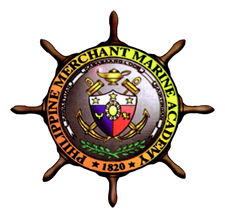- Philippine Merchant Marine Academy
Infobox_University
name = Philippine Merchant Marine Academy
motto = Righteousness, Humility, Courage
established =January 1 ,1820 ,Intramuros, Manila
type = Public
city = San Narciso
state =Zambales
country =Philippines The Philippine Merchant Marine Academy (PMMA) is amerchant marine academy in thePhilippines . Operated by the Filipino government under the supervision of the Commission on Higher Education (CHED), the academy is located in San Narciso, in the province ofZambales . Students are called midshipmen but are often also referred to ascadet s. Upon graduation students are automatically commissioned asensign s in thePhilippine Navy orPhilippine Coast Guard .Curriculum
The academy offers courses for
Bachelor of Science degrees in marine transportation andmarine engineering . Both are four-year residency courses consisting of a three-years of academic studies (first, second, and fourth years). The one-yearapprentice training (third year) is aboardcommercial vessel s plying the internationalsea lane s as deck or engine cadets. The academy also offersmaster's degree courses in shippingbusiness management and maritime education.The student body is referred to as the Corps of Midshipmen, and follows a rigid
seniority system. Each year level is a "class." The fourth-year graduating students are called "First Class Midshipmen" (1Cl), the third year is "Second Class Midshipmen" ("2Cl"), and so on. The "Fourth Class Midshipmen" are also termed as "plebe s" or "bugs", while the other classes are termed as "upperclassmen".Aspiring midshipmen who pass the
entrance examination s and rigorous medical andphysical examination s report to the academy for orientation, a month-long period ofindoctrination and training which usually begins on the first week of May. "Probationary Midshipmen" or "probies" who pass the orientation undertake anoath -takingceremony at the end and are assignedserial number s, givenuniform s, and incorporated as Fourth Class Midshipmen. Thecurriculum involves both academics andmilitary -styleleadership and discipline, aimed at training marine officers to manage coastal andforeign trade , serve asshipping executives, port supervisors, andmarine surveyor s, and serve as naval officers in time of war or national emergency. The curriculum follows the guidelines of the 1995STCW and the Policies, Standards and Guidelines for Maritime Education 1997 set by the Commission on Higher Education.The PMMA is part of the
Luzon Science Consortium .History
The academy was established during the Spanish rule of the Philippines as the "Escuela Nautica de Manila" (Nautical School of Manila) by a
royal decree issued January 1, 1820, by KingFerdinand VII of Spain through the recommendation of the Spanish Consulate of Commerce. It was then inaugurated on April 5, 1820 at Calle Cabildo inIntramuros, Manila . In 1863, the school was relocated to CalleSan Juan de Letran , then to Calle de Palacio in 1884 and then toBinondo, Manila in 1898.The academy was temporarily closed during the
Philippine Revolution . The 1898 Treaty of Paris ended theSpanish-American War and resulted in the cession of the Philippines to theUnited States . Under American occupation the academy was reopened on December 15, 1899 and renamed the Nautical School of the Philippine Islands again moving, to the U.S. Navy Warehouse at Calle Sta. Elena in San Nicolas, with Spanish as themedium of instruction .Later the academy was converted into the Philippine Nautical School. In 1913, it was reopened upon representations of progressive firms and was placed under the Philippine School for Arts and Trades located at Arroceros Street, Manila, then later moved to Roberts Street,
Pasay City . DuringWorld War I , classes were suspended under the Japanese occupation of Japan. After the liberation of Philippines and the establishment of theCommonwealth of the Philippines , the academy was placed under the supervision ofCaptain Francisco Castañeda.In 1963, R.A. 3680 converted the Philippine Nautical School into the Philippine Merchant Marine Academy and changed its course offerings to offer Bachelor of Science degrees. It was relocated at
Fort Bonifacio ,Makati City , in 1968. From then on, it was placed under the Department of Transportation and Communications. In 1996, it was placed directly under the supervision of the Commission on Higher Education. On February 2, 1998, PMMA was transferred to its current location at San Narciso, Zambales.On June 26, 2002, President
Gloria Macapagal-Arroyo signed an agreement between the governments of the Philippines andGermany through the development bankKfW . Under the agreement, KfW was to provide financial and technical assistance to the PMMA, including new equipment,infrastructure developments (including a new training center), and faculty training and development. On February 27, 2004, the foundation was laid for the construction of the PMMA Safety Training Center. The following year, project was completed with the installation of the full bridge andengine room simulator and other equipment manufactured by Rheinmetall Defence Electronics, and the delivery of a laboratory ship, RPLS "Juan Luna", nowberth ed at the Safety Training Centerpier . In 2005, there were charges ofbribery andracketeering related to the Safety Training Center construction, leading to hearings in 2006 and spring 2007 in theCongress of the Philippines . This ended with the recommendation to suspend any further payments to KfW and the German contractor.External links
* [http://www.pmma.edu.ph Official website]
Wikimedia Foundation. 2010.
